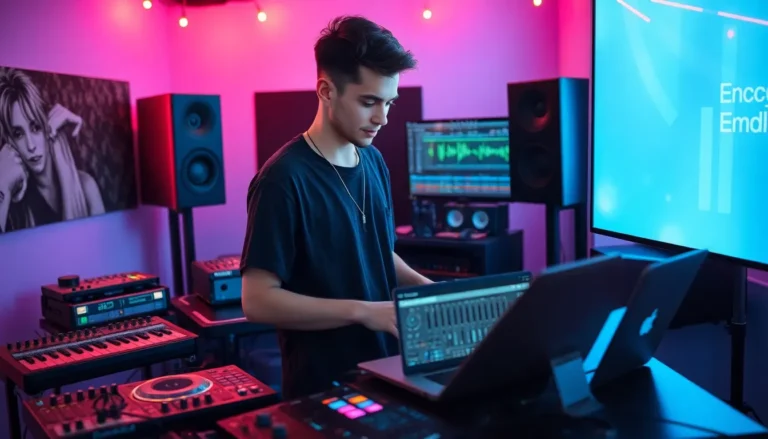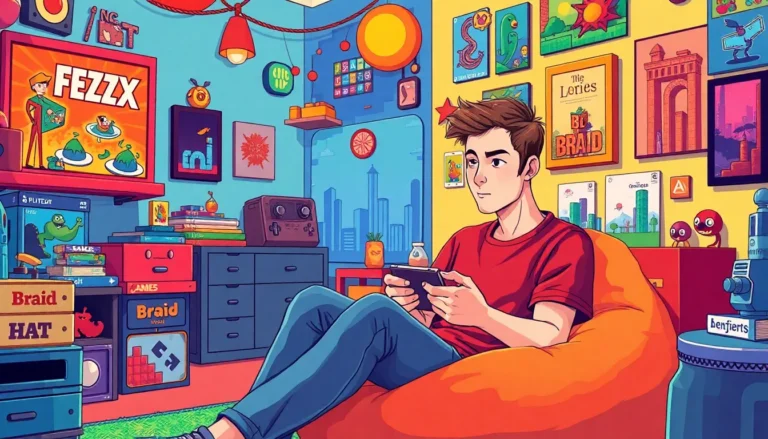In the ever-evolving world of mobile gaming, two titans stand tall: Arena of Valor and Mobile Legends. Both promise action-packed battles and strategic gameplay, but which one deserves a spot on your home screen? Picture this: you’re in a heated match, adrenaline pumping, and your fingers are dancing across the screen like they’re auditioning for a talent show.
Table of Contents
ToggleOverview of Arena of Valor and Mobile Legends
Arena of Valor (AoV) and Mobile Legends: Bang Bang (MLBB) are leading mobile multiplayer online battle arena (MOBA) games. Both titles provide immersive gameplay with intense battles among teams. Arena of Valor focuses on a roster of over 100 heroes, each offering unique abilities and playstyles. Players can engage in 5v5 matches across various maps, requiring strategic teamwork and skillful execution.
Mobile Legends also features an extensive hero lineup, boasting more than 100 characters. Matches typically involve two teams of five competing to destroy the enemy’s base. The game encourages coordination and tactics, with frequent updates introducing new heroes and gameplay features.
Graphically, Arena of Valor showcases detailed environments and visually appealing character designs. Its higher graphic quality appeals to players who prioritize visual aesthetics. In contrast, Mobile Legends opts for a more colorful art style, which some players find accessible.
In terms of gameplay mechanics, both games have similarities, like controlling a hero to defeat enemies and secure objectives. However, AoV includes features such as a dedicated jungle and unique objectives that enhance strategic depth. Mobile Legends emphasizes quick-paced matches, with a default duration of roughly 10 to 15 minutes.
When considering community and esports aspects, both games enjoy large followings. Arena of Valor attracts attention with its international tournaments and strong competitive scene. Mobile Legends has also established significant esports events, particularly in Southeast Asia, strengthening its player base.
Both Arena of Valor and Mobile Legends cater to the MOBA audience but differ in heroes, graphics, gameplay mechanics, and community engagement. Each game offers an engaging experience, leaving players to choose based on personal preferences.
Gameplay Mechanics
Both Arena of Valor and Mobile Legends feature engaging gameplay mechanics that enhance the gaming experience.
Controls and Interface
Controls in Arena of Valor focus on accessibility and precision. Players utilize a virtual joystick for movement and skill buttons for attacks. Mobile Legends offers a similar setup, providing intuitive controls that ensure responsiveness during intense battles. Both games allow customization of the interface, helping players adapt to personal preferences. The layout in Arena of Valor emphasizes visual clarity, making it easier to spot important information during matches. In contrast, Mobile Legends presents a vibrant interface, enhancing the overall aesthetic while maintaining functionality.
Game Modes
Arena of Valor presents various game modes, including 5v5 matches, which maximize strategic gameplay among teams. This title provides additional modes like Deathmatch, where players compete in chaotic battles. Similarly, Mobile Legends offers diverse gameplay modes, such as the classic 5v5 and special events that refresh the game experience. Both games support ranked and casual matchmaking, catering to players’ different skill levels. Unique to Arena of Valor, the 3v3 and 1v1 modes attract players seeking quick matches. In Mobile Legends, the Brawl mode emphasizes rapid gameplay, appealing to those preferring shorter sessions.
Graphics and Visuals
Graphics play a crucial role in the appeal of both Arena of Valor and Mobile Legends, impacting the overall player experience and enjoyment.
Character Design
Character design stands out in both games. Arena of Valor showcases a wide variety of heroes with intricate and detailed designs, ensuring each character has a unique personality and aesthetic. Characters feature vivid colors and distinctive abilities that enhance gameplay. Mobile Legends, in comparison, opts for a more playful and colorful art style. The characters are designed with exaggerated features that contribute to their charm and visual appeal. Both games ensure that each character resonates with players, encouraging engagement and affinity.
Environmental Art
Environmental art further differentiates these MOBA titles. Arena of Valor offers meticulously crafted maps with rich textures and dynamic lighting effects. Each battleground creates an immersive experience, enhancing the thrill of competition. In contrast, Mobile Legends provides vibrant and stylized environments, emphasizing a lively atmosphere. The maps feature bright colors and cohesive themes, adding to the game’s overall fun. Both titles employ their respective art styles effectively, creating engaging worlds that enhance gameplay while maintaining distinct identities.
Community and Player Engagement
Both Arena of Valor and Mobile Legends foster vibrant communities that keep players engaged. Each game supports a variety of player interactions, from casual chats to organized competitive events.
Player Base and Demographics
Arena of Valor boasts a global player base, with a significant presence in regions like Southeast Asia and Europe. Mobile Legends also has a strong following, particularly in Southeast Asia, where it often ranks among the top downloaded games. Both communities consist primarily of young adults aged 18-34. Gender distribution tends to be balanced, with some regions showing preferences. Players enjoy social features, fostering friendships within the gaming experience.
Esports Scene
The esports landscape for both games is highly competitive and rapidly evolving. Arena of Valor hosts numerous international tournaments, including the AOV World Cup, attracting top teams from various regions. Mobile Legends features its own vibrant esports ecosystem with events like MPL (Mobile Legends Professional League), further enhancing player engagement. Each game has built a dedicated fanbase that follows professional teams and players. Sponsorships and collaborations with brands enrich the competitive scene, driving excitement for both titles.
Monetization and In-Game Purchases
Both Arena of Valor and Mobile Legends utilize different monetization strategies to generate revenue through in-game purchases.
Pricing Models
Arena of Valor operates on a free-to-play model, giving players access to a substantial roster of heroes without initial fees. Players can purchase exclusive skins and other cosmetic items, enhancing their gaming experience. Mobile Legends follows a similar approach, but also features a dual currency system. Diamonds, the premium currency, allow players to acquire heroes, skins, and other upgrades more quickly than using the in-game currency known as tickets. Both games implement seasonal events, offering limited-time items at competitive prices, which encourages frequent purchases.
Value for Players
Value for players varies between the two games due to their respective offerings. Arena of Valor players benefit from constant updates and new heroes, maintaining the game’s freshness and competitiveness. Mobile Legends emphasizes the accessibility of hero acquisition, facilitating a smoother progression in gameplay. In both titles, players find opportunities for customization through unique skins, enhancing their favorite characters’ aesthetics. Players engaging in these in-game purchases often experience increased enjoyment and a sense of achievement, as both games balance free content with premium options effectively.
Conclusion
Choosing between Arena of Valor and Mobile Legends ultimately depends on personal preferences. Each game offers a unique blend of heroes gameplay mechanics and community engagement that appeals to different players.
Arena of Valor stands out with its detailed graphics and diverse game modes while Mobile Legends captivates with its vibrant art style and accessibility. Both titles have thriving esports scenes that enhance player involvement and foster competitive spirit.
Whether players prioritize aesthetics strategy or community interaction both games provide a thrilling MOBA experience that keeps them coming back for more.









